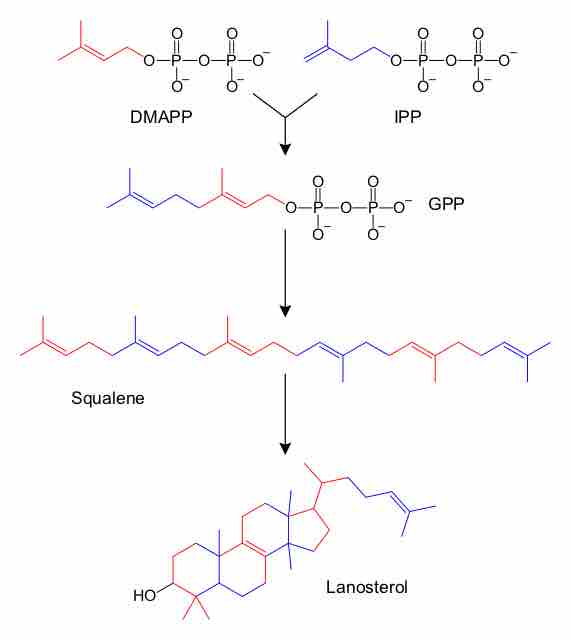A steroid is a type of organic compound that contains a characteristic arrangement of four cycloalkane rings that are joined to each other. Examples of steroids include the dietary fat cholesterol, the sex hormones estradiol and testosterone, and the anti-inflammatory drug dexamethasone. The core of steroids is composed of twenty carbon atoms bonded together that take the form of four fused rings: three cyclohexane rings (designated as rings A, B, and C in the figure to the right) and one cyclopentane ring (the D ring). The steroids vary by the functional groups attached to this four-ring core and by the oxidation state of the rings. Sterols are special forms of steroids, with a hydroxyl group at position-3 and a skeleton derived from cholestane.
Hundreds of distinct steroids are found in plants, animals, and fungi. All steroids are made in cells either from the cycloartenol (plants) or sterols lanosterol (animals and fungi) . Both lanosterol and cycloartenol are derived from the cyclization of the triterpene squalene.

Steroid Lanosterol
This is the stick model of the steroid lanosterol. The total number of carbons (30) reflects its triterpenoid origin.
Steroid biosynthesis is an anabolic metabolic pathway that produces steroids from simple precursors. A unique biosynthetic pathway is followed in animals compared to many other organisms, making the pathway a common target for antibiotics and other anti-infective drugs. In humans and other animals, the biosynthesis of steroids follows the mevalonate pathway that uses acetyl-CoA as building blocks to form dimethylallyl pyrophosphate (DMAPP) and isopentenyl pyrophosphate (IPP) . In plants and bacteria, the non-mevalonate pathway uses pyruvate and glyceraldehyde 3-phosphate as substrates.

Steroid Synthesis
This is a simplified version of the latter part of steroid synthesis pathway, where the intermediates isopentenyl pyrophosphate (PP or IPP) and dimethylallyl pyrophosphate (DMAPP) form geranyl pyrophosphate (GPP), squalene and, finally, lanosterol, the first steroid in the pathways. Some intermediates are omitted for clarity.
The non-mevalonate pathway or 2-C-methyl-D-erythritol 4-phosphate/1-deoxy-D-xylulose 5-phosphate pathway (MEP/DOXP pathway) of isoprenoid biosynthesis is an alternative metabolic pathway leading to the formation of isopentenyl pyrophosphate (IPP) and dimethylallyl pyrophosphate (DMAPP).
The classical mevalonate pathway or HMG-CoA reductase pathway is an important cellular metabolic pathway present in all higher eukaryotes and many bacteria. It is important for the production of IPP and DMAPP that serve as the basis for the biosynthesis of molecules used in processes as diverse as protein prenylation, cell membrane maintenance, hormones, protein anchoring, and N-glycosylation.
In contrast to the classical mevalonate pathway of isoprenoid biosynthesis, plants and apicomplexan protozoa such as malaria parasites have the ability to produce their isoprenoids (terpenoids) using an alternative pathway, the non-mevalonate pathway, which takes place in their plastids. In addition, most bacteria including important pathogens such as Mycobacterium tuberculosis synthesize IPP and DMAPP via the non-mevalonate pathway.